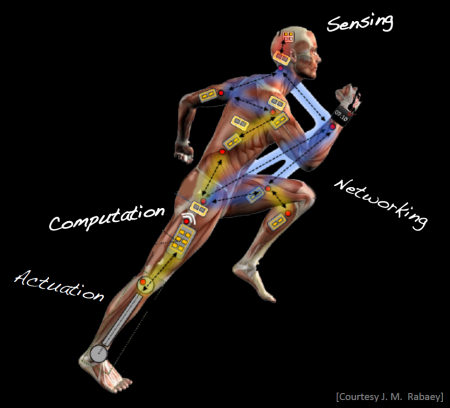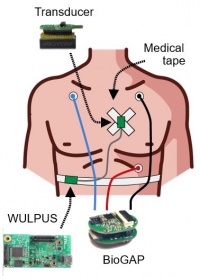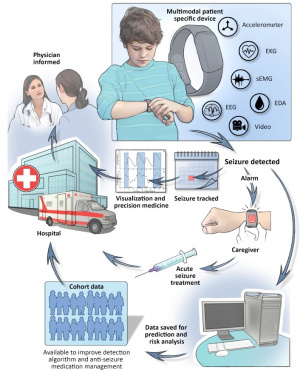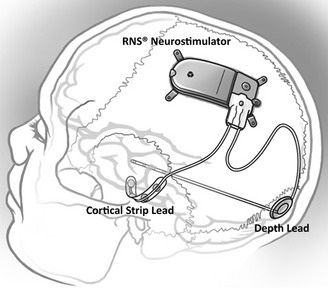Difference between revisions of "Human Intranet"
From iis-projects
(→Foundation models and LLMs for Health) |
(→Foundation models and LLMs for Health) |
||
| Line 105: | Line 105: | ||
==Foundation models and LLMs for Health== | ==Foundation models and LLMs for Health== | ||
| − | [[File: | + | [[File:LLM.jpg|border|text-top|300px]] |
| − | [[File: | + | [[File:EEG_ECG.jpg|border|text-top|400px]] |
<!-- Seizure-prediction.png --> | <!-- Seizure-prediction.png --> | ||
===Short Description=== | ===Short Description=== | ||
Revision as of 18:35, 14 December 2023
Contents
What is Human Intranet?
The world around us is getting a lot smarter quickly: virtually every single component of our daily living environment is being equipped with sensors, actuators, processing, and connection into a network that will soon count billions of nodes and trillions of sensors. These devices only interact with the human through the traditional input and output channels. Hence, they only indirectly communicate with our brain—through our five sense modalities—forming two separate computing systems: biological versus physical. It could be made a lot more effective if a direct high bandwidth link existed between the two systems, allowing them to truly collaborate with each other and to offer opportunities for enhanced functionality that would otherwise be hard to accomplish. The emergence of miniaturized sense, compute and actuate devices as well as interfaces that are form-fitted to the human body opens the door for a symbiotic convergence between biological function and physical computing.
Human Intranet is an open, scalable platform that seamlessly integrates an ever-increasing number of sensor, actuation, computation, storage, communication and energy nodes located on, in, or around the human body acting in symbiosis with the functions provided by the body itself. Human Intranet presents a system vision in which, for example, disease would be treated by chronically measuring biosignals deep in the body, or by providing targeted, therapeutic interventions that respond on demand and in situ. To gain a holistic view of a person’s health, these sensors and actuators must communicate and collaborate with each other. Most of such systems prototyped or envisioned today serve to address deficiencies in the human sensory or motor control systems due to birth defects, illnesses, or accidents (e.g., invasive brain-machine interfaces, cochlear implants, artificial retinas, etc.). While all these systems target defects, one can easily imagine that this could lead to many types of enhancement and/or enable direct interaction with the environment: to make us humans smarter!
Here, in our projects, we mainly focus on sensor, computation, communication, and emerging storage aspects to develop very efficient closed-loop sense-interpret-actuate systems, enabling distributed autonomous behavior.
Prerequisites and Focus
If you are an B.S. or M.S. student at the ETHZ, typically there is no prerequisite. You can come and talk to us and we adapt the projects based on your skills. The scope and focus of projects are wide. You can choose to work on:
- Exploring new Human Intranet/IoT applications
- Algorithm design and optimizations (Python)
- System-level design and testing (Altium, C-programming)
- Sensory interfaces (analog and digital)
Useful Reading
- The Human Intranet--Where Swarms and Humans Meet
- Efficient Biosignal Processing Using Hyperdimensional Computing: Network Templates for Combined Learning and Classification of ExG Signals
- A review of classification algorithms for EEG-based brain–computer interfaces: a 10 year update
Available Projects
Here, we provide a short description of the related projects for you to see the scope of our work. The directions and details of the projects can be adapted based on your interests and skills. Please do not hesitate to come and talk to us for more details.
Wearables for health and physiology
Short Description
In this research area, we develop wearable systems, algorithms, and applications for monitoring health- and physiological-related parameters in innovative ways. Examples include (but are not limited to): heart rate and respiration rate monitoring, blood pressure monitoring, bladder monitoring, drowsiness detection, monitoring of muscle contractions and identification of innervations, ...
For wearables based on ultrasound, see also the dedicated Ultrasound section: Digital Medical Ultrasound Imaging
Available Projects
- EEG-based drowsiness detection
- In-ear EEG signal acquisition
- EEG earbud
- Advanced EEG glasses
- Design of combined Ultrasound and PPG systems
- Wearable Ultrasound for Artery monitoring
- Machine Learning for extracting Muscle features from Ultrasound raw data
Brain-Machine Interfaces and wearables
Short Description
Noninvasive brain–machine interfaces (BMIs) and neuroprostheses aim to provide a communication and control channel based on the recognition of the subject’s intentions from spatiotemporal neural activity typically recorded by EEG electrodes. BMIs are a special kind of HMI, focused on the brain. What makes BMIs particularly challenging is their susceptibility to errors over time in the recognition of human intentions.
In these projects, our goal is to develop efficient and fast learning algorithms that replace traditional signal processing and classification methods by directly operating with raw data from electrodes. Furthermore, we aim to efficiently deploy those algorithms on tightly resource-limited devices (e.g., Microcontroller units) for near sensor classification using artificial intelligence.
- WATCH OUR DEMO: EEG-HEADBAND CONTROLLING A DRONE: https://www.youtube.com/watch?v=3-DysFptdRI
Links
- Q-EEGNet: an Energy-Efficient 8-bit Quantized Parallel EEGNet Implementation for Edge Motor-Imagery Brain–Machine Interfaces
- An Accurate EEGNet-based Motor-Imagery Brain–Computer Interface for Low-Power Edge Computing
- Fast and Accurate Multiclass Inference for Motor Imagery BCIs Using Large Multiscale Temporal and Spectral Features
- Hyperdimensional Computing for Blind and One-Shot Classification of EEG Error-Related Potentials
- Exploring Embedding Methods in Binary Hyperdimensional Computing: A Case Study for Motor-Imagery based Brain-Computer Interfaces
Available Projects
- Exploratory Development of a Unified Foundational Model for Multi Biosignal Analysis
- Deep Learning Based Anomaly Detection in ECG Signals Using Foundation Models
- Pretraining Foundational Models for EEG Signal Analysis Using Open Source Large Scale Datasets
- EEG-based drowsiness detection
- In-ear EEG signal acquisition
- EEG earbud
- Advanced EEG glasses
- Predict eye movement through brain activity
- BCI-controlled Drone
Epilepsy Seizure Detection Device
Short Description
Epilepsy is a brain disease that affects more than 50 million people worldwide. Conventional treatments are primarily pharmacological, but they can require surgery or invasive neurostimulation in the case of drug-resistant subjects. In these cases, personalized patient treatments are necessary and can be achieved with the help of long-term recording of brain activity. In this context, seizure detection systems hold promise for improving the quality of life for patients with epilepsy, providing non-stigmatizing and reliable continuous monitoring during real-life conditions. In this project, our goal is to develop efficient techniques for EEG as well as non-EEG signals to detect an upcoming seizure in an ultra-low-power device. In this project, our goal is to develop efficient techniques for EEG as well as non-EEG signals to detect an upcoming seizure in an ultra-low-power device. This covers a wide range of analog and digital techniques.
Links
- The SWEC-ETHZ iEEG Database and Algorithms
- Epilepsy monitoring and seizure forecasts at Wyss Center
- Controlling tinnitus with neurofeedback
Available Projects
- Advanced EEG glasses
- Self Aware Epilepsy Monitoring
- EEG artifact detection with machine learning
- EEG artifact detection for epilepsy monitoring
Foundation models and LLMs for Health
Short Description
Foundation models and Large Language Models (LLMs) are becoming increasingly popular in the AI domain, and they hold great potential for health applications as well. In this project, our goal is to develop efficient techniques for foundation models and LLMs applied to Health applications, such as analyses of EEG brain signals.
In modern healthcare and biomedical research, applying advanced computational models, particularly Foundation Models and Large Language Models (LLMs), is revolutionizing our approach to understanding and interpreting complex biosignals. At IIS, we are at the forefront of this transformative journey, exploring the depths of how these models can be harnessed to analyze and interpret critical biosignals such as electroencephalograms (EEG) and electrocardiograms (ECG).
Foundation Models, a term broadly encompassing a range of powerful, pre-trained models, are reshaping our capacity to process and understand vast datasets. These models, initially trained on extensive and diverse data, can be fine-tuned to specific tasks, offering unprecedented accuracy and efficiency. Their adaptability makes them particularly suitable for biosignal analysis, where the nuances of EEG and ECG data require both precision and contextual understanding.
Large Language Models (LLMs), a subset of Foundation Models, have successfully processed and generated human language. At IIS, we are exploring the innovative application of LLMs beyond text, venturing into the realm of biosignal interpretation. This involves training these models to 'understand' the 'language' of biosignals, translating complex patterns into meaningful insights.
Our focus on EEG and ECG signals is driven by the rich information these biosignals offer in understanding human health. EEGs, which record brain activity, and ECGs, which monitor heart rhythms, are pivotal in diagnosing and managing various health conditions. By leveraging Foundation Models and LLMs, we aim to enhance the accuracy of diagnoses, predict health outcomes, and personalize patient care.
At IIS, we invite Master's students to delve into this pioneering field. Our projects offer opportunities to engage with cutting-edge technologies, apply them to real-world health challenges, and contribute to a future where healthcare is more predictive, preventive, and personalized. Join us in this exciting journey to redefine the boundaries of healthcare and technology.
Links
Available Projects
- Exploratory Development of a Unified Foundational Model for Multi Biosignal Analysis
- Deep Learning Based Anomaly Detection in ECG Signals Using Foundation Models
- Pretraining Foundational Models for EEG Signal Analysis Using Open Source Large Scale Datasets
Projects in Progress
Completed Projects
These are projects that were recently completed:
- Smart e-glasses for concealed recording of EEG signals
- Wireless EEG Acquisition and Processing
- Ultrasound based hand gesture recognition
- Design of combined Ultrasound and Electromyography systems
- Ultra low power wearable ultrasound probe
- Hardware Constrained Neural Architechture Search
- Memory Augmented Neural Networks in Brain-Computer Interfaces
- Low Latency Brain-Machine Interfaces
- Deep Convolutional Autoencoder for iEEG Signals
- TCNs vs. LSTMs for Embedded Platforms
- An Energy Efficient Brain-Computer Interface using Mr.Wolf
- Exploring Algorithms for Early Seizure Detection
- Improving Resiliency of Hyperdimensional Computing
- Toward Superposition of Brain-Computer Interface Models
- FPGA Optimizations of Dense Binary Hyperdimensional Computing
- Fast and Accurate Multiclass Inference for Brain–Computer Interfaces
Where to find us
| Thorir Mar Ingolfsson | Sebastian Frey | Dr. Xiaying Wang | Dr. Andrea Cossettini |
| Office: OAT U21 | Office: ETZ J69.2 | Office: OAS J36 / ETZ J68.2 | Office: OAT U27 / ETZ J69.2 |
| e-mail: thoriri@iis.ee.ethz.ch | e-mail: sefrey@iis.ee.ethz.ch | e-mail: xiaywang@iis.ee.ethz.ch | e-mail: cossettini.andrea@iis.ee.ethz.ch |








